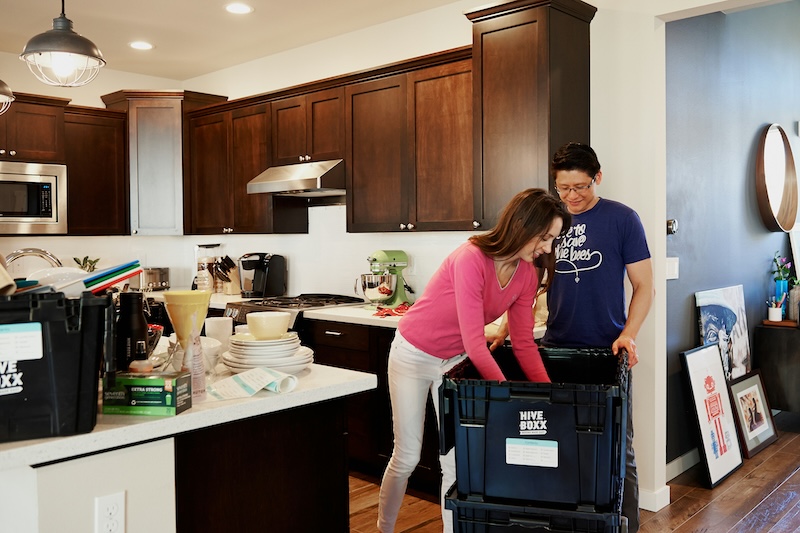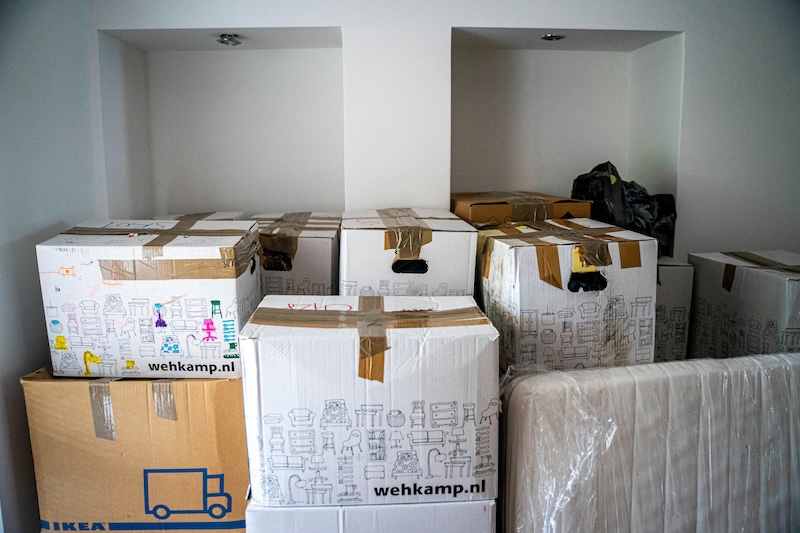You’re moving soon and ready to tackle the newest chapter of your life. Congratulations!
We understand how daunting moving from one place to another can be. Packing, organizing, and planning every aspect of your move can quickly feel overwhelming, especially if it’s a big move and you don’t know what to expect.
Luckily, you don’t have to face it alone. With this guide, we answer everything you need to know about moving, including how long it takes to move, tips on efficient packing and unpacking, and the timelines to expect throughout the process.
On Average, How Long Does It Take To Move?
The entire moving process varies from one household to another. Generally, though, a local move can take two to three weeks, while a long-distance move can take four to six weeks. This timeline includes planning, packing, booking movers, the actual moving day, and settling into the new home.
Factors that influence how long your move takes include:
Size of your home
Naturally, the bigger your home, the longer it’ll take to move. A studio or one-bedroom flat may take only a couple of days to pack, while a 2-story family home can take weeks.
Volume of belongings
More belongings mean more time spent packing and more boxes to load and unload. Those moving from their primary home to another will also have more items to pack because of all the items they’ve accumulated over the years.
Type of belongings
Some items are easier to pack than others.
Clothes, linens, and books, for example, can easily be packed into boxes or luggage without extra precaution.
On the other hand, delicate items like fine china, glassware, and artwork need to be carefully wrapped and padded to keep them safe, doubling or even tripling the moving time.
The same is said for large furniture, electronics, and appliances. You’ll have to either disassemble them—which can take hours if not days—and carefully wrap and maneuver them into an out-of-the-way location until they can be loaded onto the moving truck or handled by professional movers.
Distance
Local moves can be completed in a single day, whereas long-distance or international relocations can stretch over several days or even weeks.
Unforeseen circumstances
Unforeseen circumstances, such as extreme weather or issues with the moving company, can cause delays of hours or days.
Therefore, it’s always a good idea to have contingency plans in place and confirm all arrangements with the moving company ahead of time.
It’s also wise to add a few extra days as a buffer before and after your moving day if you have important commitments around that time.
DIY vs. Professional Help
Needless to say, DIY moves take longer than professional moves. You’ll need to handle the packing, organizing, disassembling, loading, and unloading yourself, which requires lots of effort, planning, and sometimes even multiple trips. It can also result in accidental damage during both the packing and moving processes, lengthening the moving time even more.
Many people don’t realize just how fragile things can be until they attempt to move them without professional help. For example, refrigerators can be damaged if tipped incorrectly, and fragile electronics may break if not securely packed.
Additionally, DIY moves often lead to property damage, such as scratched floors, dented walls, and broken door frames when moving large or heavy furniture, further increasing the moving timeline if you’re required to fix these damages before settling into your new home.
Hiring professional movers speeds up the timeline considerably. Experienced movers not only have the manpower to complete the job in fewer hours, but they also use specialized tools and packing/loading techniques to reduce the risk of damage.
Moreover, many movers offer protection plans or insurance against loss or damage during transit. So if you’re moving valuable items, hiring professional movers is the best thing you can do.
Packing Time: How Long Does It Take to Pack?
Here’s a look at how long it takes to pack different areas of a home:
How Long Does It Take To Pack A House?
Packing an entire house can be a time-consuming process, so hiring professional help is worth considering.
For an average three-bedroom house, it can take between 2 and 3 weeks without professional help, and up to 24 hours with professional help.
Packing involves sorting, decluttering, and wrapping fragile belongings, as well as disassembling and boxing furniture and appliances.
How Long Does It Take To Pack An Apartment?
Packing an apartment is generally quicker than packing a full house because it has fewer rooms and a smaller volume of belongings.
On average, a one- or two-bedroom apartment may take 1 to 3 days to pack, depending on how long you’re willing to spend packing per day.
Factors like the amount of furniture, the number of fragile items, and whether the apartment has communal storage areas can also affect this timeline.
How Long Does It Take To Pack A Studio Apartment?
A studio apartment is the quickest to pack due to its open layout and limited space.
Most people can pack a studio in 1 to 2 days, depending on how many personal items they’ve accumulated over the years.
People who live in studios are often students, young professionals, and single or unmarried individuals, so they usually don’t have much stuff to pack.
A smaller volume of belongings equals a quicker and less stressful move since there are fewer boxes and pieces of furniture to handle.
How Long Does It Take To Pack A Kitchen
The kitchen can be one of the most time-consuming areas to pack, mostly because it often contains a large number of fragile items, appliances, and miscellaneous tools.
The kitchen alone can take half a day to an entire day to pack. Here are some tips to help you pack the kitchen more efficiently.
Sort, Select, and Simplify
If you’ve lived in your home for a while, you’ve likely accumulated dozens of unnecessary miscellaneous items for your kitchen—many of which you don’t need.
Go through each and every single one of your cupboards and be selective about what should and shouldn’t be packed.
Put the items you’ll bring with you in one box, another for items to donate, and a third for things to throw away or recycle.
Look at everything with a critical eye. Do you really need that Snoopy spatula that you’ve used a grand total of three times? What about the avocado slicer you were influenced to buy, or that egg separator that works half the time?
Donate unneeded items to shelters or food banks, or put them up for sale on Facebook Marketplace or Craigslist if you have the time. You can also give unneeded items to friends, family, or neighbors.
Segregate Your Essentials
Take the box with the items you plan to keep and divide it into three additional categories: one for everyday essentials, two for fragile items, and three for seasonal belongings.
Everyday essentials, as the name suggests, are items you use all the time. Think spoons, forks, knives, a chopping board, measuring cups, and a whisk.
Fragile items like ceramic plates, glasses, and mugs should be wrapped in bubble wrap, packing paper, or towels or blankets. Make sure to label that box as ‘fragile’ and mark which side should face up to prevent accidental damage.
As for seasonal items, these include holiday dinnerware, large serving trays, special baking pans, and equipment you only use occasionally.
Pack Large Items Separately
In a separate, larger box, pack items like pots, pans, crockery, mixing bowls, and other kitchenware that don’t require as much protection as plates and glasses.
Put heavier items at the bottom and lighter ones on top, and fill empty spaces with towels or paper so the contents don’t shift during transport.
Pack Small Kitchen Appliances
Pack small kitchen appliances like coffee makers, rice cookers, toasters, and blenders into a large box.
If you still have the original boxes the appliances came with and you have extra space to spare, go ahead and use them. Otherwise, wrap each item in bubble wrap or packing paper, and pad empty spaces with towels or foam peanuts. Disassemble appliances as necessary.
Tackle Large Kitchen Appliances
Large kitchen appliances are the hardest to pack because of how heavy and fragile they often are.
The best way to deal with large appliances is to hire professional movers so they can do all the heavy lifting themselves. They’ll disconnect, disassemble, and secure them before transporting them with specialized equipment like straps and dollies.
If you want to do the move yourself, start by disconnecting the appliance and giving it a thorough clean. Remove leftovers from the fridge and defrost the ice, clean out crusted food from the oven/microwave, and remove all the dishes from the dishwasher.
Then, carefully disassemble the removable parts and pack them separately. Use a manual guide or look up how to disassemble the appliances online to ensure you’re doing it properly.
Finally, move the appliance close to the exit so it can be loaded onto the moving truck quickly and safely. If the appliance you’re moving is too heavy or doesn’t have wheels, you’ll need to use a dolly, straps, sliders, or moving blankets.

How Long Does It Take To Pack a Bedroom
Packing a bedroom can take a few hours to a few days, depending on the number of items you have and how meticulous you are with your packing.
Technically, you can finish packing your bedroom in under two hours by shoving your clothes and other items into a box without organizing them. But if you want to fold your clothes, group similar items together, and declutter your room while you’re at it, it’ll naturally take longer.
Here are some tips to help you pack a bedroom:
Throw Out Unnecessary Clothes
Get rid of anything you no longer want, use, or need. Again, be extremely picky. Segregate your clothes into three categories: to keep, to donate, and to discard. Put aside clothes that:
- Is damaged beyond repair
- Shows signs of wear, such as fraying, fading, or staining
- You haven’t worn for a long time (and don’t see yourself wearing it in the next couple of months)
- You have multiples of
- No longer fits your style or is out of date
- No longer fits you
Donate or sell clothes that are in good condition, and throw out those that are unsalvageable. While you’re at it, get rid of broken or unused clothing hangers.
And if you have the time, wash the dirty clothes so you don’t have to immediately do laundry after moving.
Store Your Accessories Separately
Store your accessories in separate boxes or bags.
For small items like jewelry, use small compartments or padded cases to prevent tangling or damage.
Shoes can be packed in their original boxes or in larger bins, with tissue paper or bubble wrap between pairs to maintain their shape.
Pack Up Sheets, Blankets, and Bedding Materials
Gather all your sheets, blankets, pillows, comforters, and other bedding materials and fold them up in a neat roll. Pack them into large boxes, plastic bins, or vacuum-sealed bags to save space.
Wash and dry any bedding that needs washing so everything is clean when you arrive at your new home.
Disassemble Furniture
Wipe down and clean your bedroom furniture, then disassemble it for the move.
Remove bed frames, headboards, drawers, and detachable parts from desks, dressers, or nightstands.
Keep all screws, bolts, and small hardware in labeled bags so you can easily reassemble the furniture in your new home.
Wrap furniture legs with leg protectors or bubble wrap, and cover surfaces with paper, bubble wrap, or shrink wrap to protect them from scratches and dents during transport.

Moving Into Different Types of Homes
On average, here’s how long it’ll take to move into different types of homes:
How Long Does It Take To Move In A House?
In the United States, a single-family home measures around 2,000 square feet, with two bedrooms, two bathrooms, a living room, dining room, kitchen, and additional spaces like a home office or laundry room.
Assuming you’re moving into a house of about the same size and specifications, it’ll take you around 20 to 30 hours to fully move into the house.
Packing often takes longer than moving, especially if you organize your items neatly into labeled boxes.
Here are some estimates:
- Living room: 2 to 3 hours
- Kitchen: 6 to 10 hours
- Bedrooms: 2 to 5 hours per room
- Bathrooms: 30 minutes to 1 hour
- Garage or Storage: 1 to 3 hours
If the home comes pre-furnished, you don’t have to spend as much time unpacking your items. But if you’re moving into an empty house, you’ll spend extra hours assembling and arranging furniture, setting up appliances, and organizing each room.
How Long Does It Take To Move Into An Apartment?
Depending on how large the apartment is, it can take anywhere from a few hours to several days to pack everything properly. Smaller studios or one-bedroom apartments may only require a day or two, while larger two- or three-bedroom apartments can take multiple days.
How Long Does It Take To Move a 1 Bedroom Apartment?
Moving to a one-bedroom apartment can take three to six hours, again depending on how large the apartment is and how many items you’re unpacking.
How Long Does It Take To Move a 2 Bedroom Apartment?
In a two-bedroom apartment, it may take you an additional 3 or so hours for the extra room. If the apartment is located upstairs or in a building without an elevator, moving will take longer because you’ll need to carry boxes and furniture up and down the stairs.
How Long Does It Take To Pack And Move?
The entire moving process, which includes decluttering, disassembling, organizing, packing, cleaning, loading and unloading, and settling into your new home, can take several days to a few weeks, depending on the size of your home, the amount of belongings, and whether you hire professional movers.
Packing is the most time consuming part of the move, as it requires you to sort, organize, disassemble, and wrap all your belongings.
Loading and unloading is significantly faster with professional help, and can only take two to three hours, sometimes shorter.
Moving into your new home can take several days to get everything in order, but the process is usually fairly quick if you prioritize essential items and unpack systematically.
Here’s how:
- Unpack items you’ll need immediately, like beddings, toiletries, basic kitchenware, and a few changes of clothes. Place them in their designated spots so they’re ready to use.
- Tackle one room at a time rather than moving between rooms. Start with the most important spaces like the bedroom, kitchen, and bathroom, then gradually move on to less important rooms like the garage, storage, attic, basement, etc.
- Unpack items according to their categories (e.g., living room, bedroom, kitchen) to avoid clutter. Once one box is empty, move on to the next.
- Organize as you go. Don’t leave things on the floor or stuff them into random spots. Place each item in its intended location as you unpack.
- Tackle decoratives last. Unpack picture frames, ornaments, artwork, and decorative cushions once the main furniture and daily-use items are in place.
Loading and Transportation
Loading and transportation are both among the easiest and hardest parts of the move.
Easy because it’s mostly a matter of carrying boxes and furniture onto the truck. Hard because heavy, bulky, or fragile items require careful handling, proper equipment, and extra hands to avoid damage or injury.
Here’s how long it typically takes to load and transport items for a move:
How Long Does It Take Movers To Load A Truck?
Professional movers are trained to load trucks efficiently and safely. A standard two- to three-bedroom home can take 2 to 5 hours to load, depending on the volume of belongings, the number of large or fragile items, and the accessibility of your home.
Movers use equipment like straps, dollies, and moving blankets to protect items while making the most out of the space in the truck. Moreover, moving companies take into account the size of your home and send enough personnel to complete the job as quickly as possible, with a truck size to match.
Having everything packed and ready to go before the movers arrive significantly cuts down on loading time.
How Long Does It Take To Load A Moving Truck Yourself?
Loading a moving truck yourself can take double the time as it would with professional movers, especially without extra help or proper equipment. Many families rent a truck for two to three days before the actual move and spend that time loading boxes and furniture.
How Long Does It Take To Unload A Moving Truck?
Unloading is often faster than loading.
When loading, you need to carefully plan the order of items, stack boxes securely, tie fragile items, and distribute weight evenly. With unloading, the only thing you have to do is to carefully move items from the truck to their designated rooms.
On average, professional unloading can take 30 minutes to an hour, while a DIY unloading can take 2 to 3 hours.
How Long Does It Take To Move Long Distance?
A long-distance move can take several days to a few weeks for your belongings to arrive, depending on where you’re moving to. The further the distance, the longer the transit time.
According to the Federal Motor Carrier Safety Administration, drivers can legally drive up to 11 hours per day and must take a 10-hour break before moving again.
Other than distance, factors that can determine transit time include:
Time of Year and Weather
For many countries, summer is the peak moving season. This means higher demand for moving services and potentially longer wait times for scheduling and transit.
Fall and winter offer higher availability but also with the risk of adverse weather conditions like rain, strong winds, or snow, which can slow down transportation and increase the risk of delays.
Unforeseen Circumstances
Anything can happen on the road. The truck might pop a tire, might get into a car accident, or might have issues with the furniture they’re moving.
Because of this, it’s always best to have a contingency plan in place in case something unexpected happens. Leave behind essentials (change of clothes, basic toiletries, important documents, and medications) to use while waiting for the truck to arrive at your new home.
Amount of Items You’re Transporting
A big move may require multiple trips, larger trucks, and slower driving, so make sure the load is secure. Heavy or bulky items also require extra care on the road, which can further slow down the journey.
How Long Does It Take To Move To Another State?
Again, it depends on the distance between your current home and your new one.
A moving truck has a maximum speed limit of 55 miles per hour. So if you’re from New York City and moving to Virginia—that’s a distance of around 550 miles—the move can take around 10 hours of driving in ideal conditions (no traffic, no bad weather, and no rest breaks).
That said, determining when your items will arrive isn’t as simple as calculating the speed of the truck and distance of your new home. Realistically, a 550-mile move will require about 2 days of travel with a travel time of 6 hours on the road per day.
How Long Does It Take Movers To Deliver Cross Country?
Cross-country moving services can take between 1 to 3 weeks to transport your items. The moving company will give you an average estimate so you have a rough idea of what to expect, but always add several days to that number for unforeseen circumstances during the transit.
Settling In After The Move
You’ve packed your stuff, loaded it into the truck, and arrived at your new home. You’re near the finish line!
The next step is settling in, which involves unloading, unpacking, organizing your belongings, arranging furniture, and setting up utilities and appliances.
Settling in can take several days to over a month, depending on the volume of the move. If you’re moving to an empty house, the settling-in process takes even longer.
How Long Does It Take To Unpack After Moving
Unpacking can take a few hours to several days. Here’s an estimate of how long it takes to unpack each room:
- Bedroom: 2 to 4 hours, with the majority of the time dedicated to organizing and putting away clothes and personal items. You’ll spend less time if you’ve previously folded and organized your clothes before the move.
- Kitchen: 4 to 8 hours, due to the number of items, appliances, and fragile dishware you’ll have to unpack. If the kitchen doesn’t come with appliances, you have to take the time to install the refrigerator, oven, microwave, dishwasher, and other large items.
- Living room: 2 to 3 hours; longer if you have to move living room furniture like sofas, tables, cabinets, TV stand, and the like. If the living room is already furnished, you only have to unpack smaller items, arrange decor, and set up electronics.
- Bathroom: 15 to 30 minutes; the bathroom often comes fully equipped with the toilet, tub, sink, etc., so you only have to arrange toiletries, towels, and maybe hang a mirror for it to be ready for use.
- Garage or storage areas: 1 to 3 hours, depending on the number of boxes and items you’re planning to store.
Moving takes a lot out of a person, so you’ll likely spend two to three hours a day unpacking and organizing before calling it quits for the day.
The hardest part of the move is over, and as long as you’ve unpacked your essentials, you can take your time with the remaining items.
Unpack at a comfortable pace, focusing on one room before moving to the next.
How Long Does It Take To Transfer Utilities
Transferring utilities to a new home can take several weeks. Most internet providers can get your WiFi services up and running within a week, so long as no extensive wiring is required. If there’s a problem with the line, it can take 2 to 4 weeks to schedule an engineer visit.
Electricity, gas, and water services don’t take much time to install, typically requiring several hours to a few days to transfer to your name. Update your address with your new service providers and make sure you call your former utility company to confirm you’re all paid up and that your account is closed.
Other utilities like sewer, trash, and recycling are often handled by the local municipality or city government. Contact your city’s public works or sanitation department, give them your new address and move-in date, and pay any applicable fees.
If you’re moving to an area with a Homeowner’s Association (HOA), the organization will contact you several days after your move to inform you of community rules, dues, and fees.




